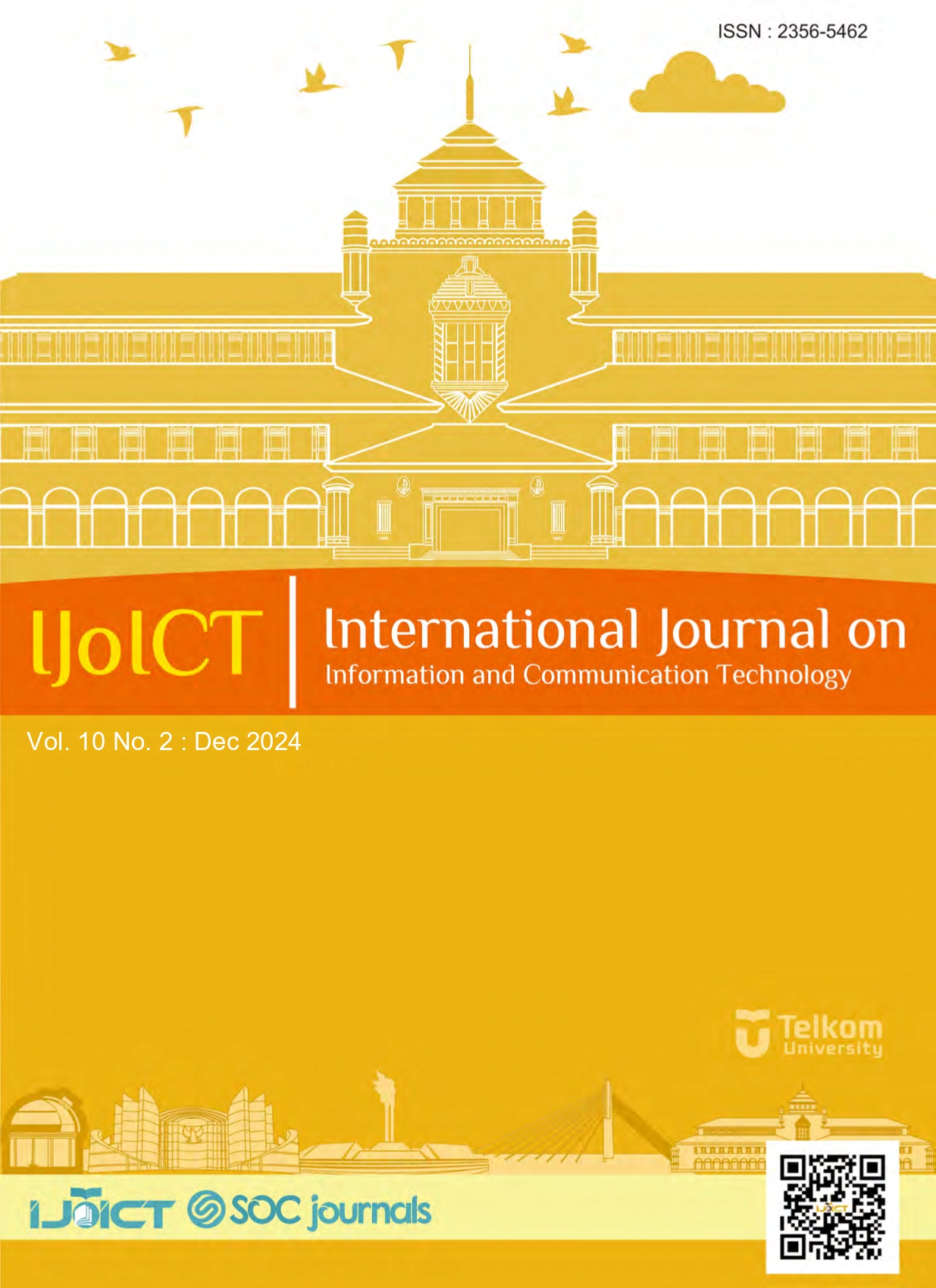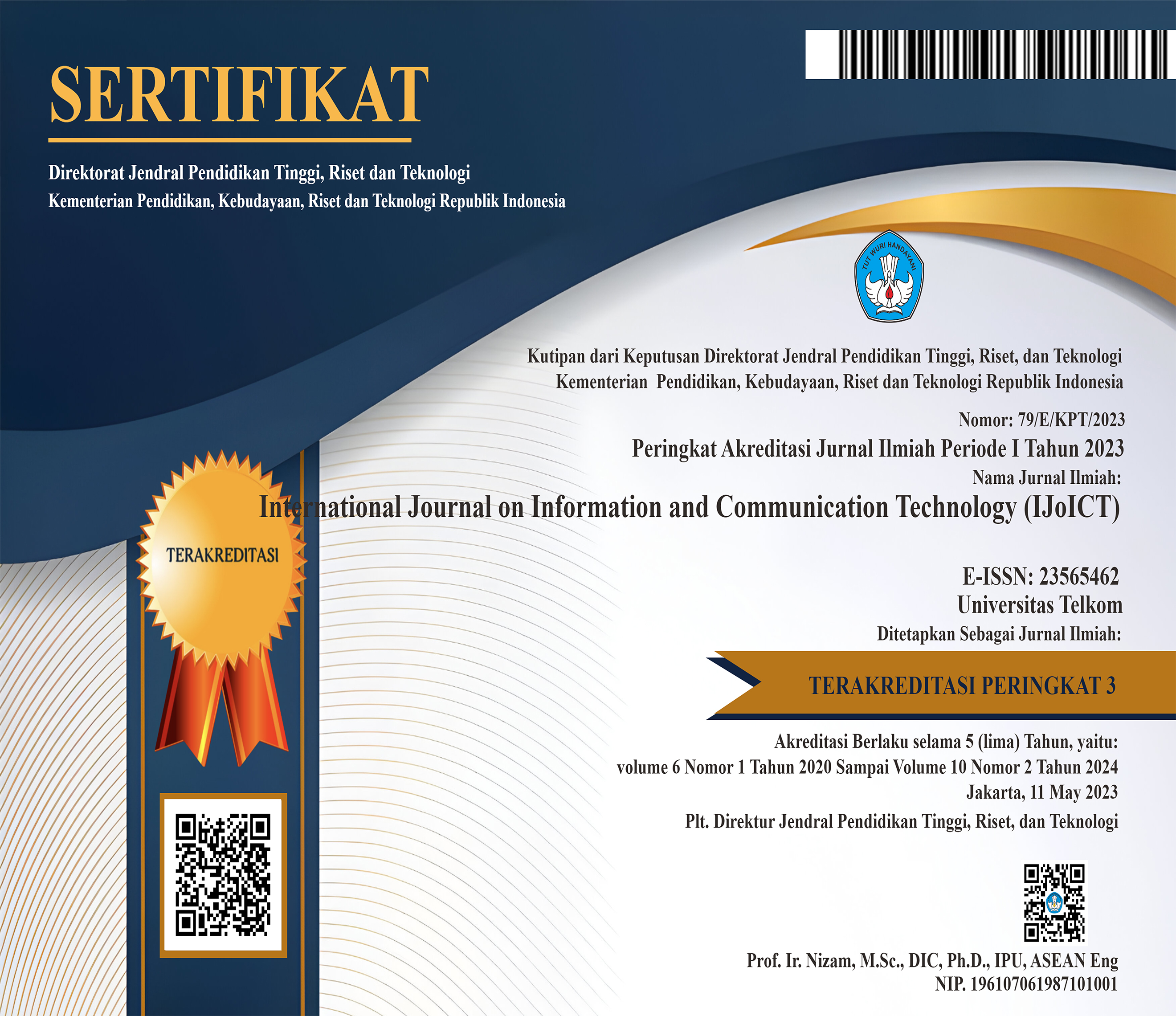Geospatial Sentiment Analysis Using Twitter Data on Natural Disasters in Indonesia with Support Vector Machine (SVM) Algorithm
DOI:
https://doi.org/10.21108/ijoict.v10i2.1032Keywords:
Geospatial analysis, Natural disasters, Sentiment analysis, SMOTE, SVM, TF-IDF, TwitterAbstract
Twitter serves as a crucial platform for expressing public sentiment during natural disasters. This study conducts geospatial sentiment analysis on 988 labeled tweets related to the eruption of Mount Marapi, categorized into four aspects which are Basic Needs, Impact and Damage, Response and Action, and Weather and Nature. The preprocessing stage includes data cleaning, case folding, tokenization, normalization, stopword removal, and stemming. Feature extraction uses TF-IDF, while class imbalance is addressed with SMOTE. Each aspect is modeled separately using Support Vector Machine (SVM) with linear, polynomial, and RBF kernels, evaluated through 10-fold cross-validation. Results show that the linear kernel performed best across most aspects, achieving 92.42% accuracy for Impact and Damage, 80.38% for Response and Action, and 94.22% for Weather and Nature. Meanwhile, the RBF kernel showed competitive performance with 89.54% accuracy for Basic Needs. Geospatial visualization highlights regional sentiment distribution patterns, offering insights into public responses across Indonesian regions. This study demonstrates the effectiveness of the linear kernel in SVM for sentiment classification and emphasizes the role of geospatial analysis in understanding public sentiment during natural disasters.
Downloads
References
[1] Wei, H. L. (2021). Natural Hazards: Volcanic Eruptions. In Encyclopedia of Security and Emergency Management (pp. 697-700). Cham: Springer International Publishing.
[2] Mirbabaie, M., Bunker, D., Stieglitz, S., Marx, J., & Ehnis, C. (2020). Social media in times of crisis: Learning from Hurricane Harvey for the coronavirus disease 2019 pandemic response. Journal of Information Technology, 35(3), 195-213.
[3] Duc, H. M., & Ha, N. T. T. (2024). Enhancing Disaster Preparedness, Emergency Response and Resource Allocation using Big Data Integration and Predictive Analytic. Journal of Big-Data Analytics and Cloud Computing, 9(1), 1-13.
[4] Liu, B. (2022). Sentiment analysis and opinion mining. Springer Nature.
[5] Dervenis, C., Kanakis, G., & Fitsilis, P. (2024). Sentiment analysis of student feedback: A comparative study employing lexicon and machine learning techniques. Studies in Educational Evaluation, 83, 101406.
[6] Pisner, D. A., & Schnyer, D. M. (2020). Support vector machine. In Machine learning (pp. 101-121). Academic Press.
[7] Guido, R., Ferrisi, S., Lofaro, D., & Conforti, D. (2024). An Overview on the Advancements of Support Vector Machine Models in Healthcare Applications: A Review. Information, 15(4), 235.
[8] Jahan, I., Islam, M. N., Hasan, M. M., & Siddiky, M. R. (2024). Comparative analysis of machine learning algorithms for sentiment classification in social media text. World J. Adv. Res. Rev, 23(3), 2842-2852.
[9] Abdullah, D. M., & Abdulazeez, A. M. (2021). Machine learning applications based on SVM classification a review. Qubahan Academic Journal, 1(2), 81-90.
[10] Nafis, N. S. M., & Awang, S. (2021). An enhanced hybrid feature selection technique using term frequency-inverse document frequency and support vector machine-recursive feature elimination for sentiment classification. Ieee Access, 9, 52177-52192.
[11] Buchel, O., & Pennington, D. R. (2022). Geospatial analysis. The SAGE handbook of social media research methods, 255.
[12] Jabalameli, S., Xu, Y., & Shetty, S. (2022). Spatial and sentiment analysis of public opinion toward COVID-19 pandemic using twitter data: At the early stage of vaccination. International Journal of Disaster Risk Reduction, 80, 103204.
[13] Beigi, G., Hu, X., Maciejewski, R., & Liu, H. (2016). An overview of sentiment analysis in social media and its applications in disaster relief. Sentiment analysis and ontology engineering: An environment of computational intelligence, 313-340.
[14] Lock, O., & Pettit, C. (2020). Social media as passive geo-participation in transportation planning–how effective are topic modeling & sentiment analysis in comparison with citizen surveys?. Geo-Spatial Information Science, 23(4), 275-292.
[15] Mursi, J. K. A., Subramaniam, P. R., & Govender, I. (2023, September). Exploring the Influence of Pre-Processing Techniques in Obtaining Labelled Data from Twitter Data. In 2023 IEEE AFRICON (pp. 1-6). IEEE.
[16] Mujahid, M., Kına, E. R. O. L., Rustam, F., Villar, M. G., Alvarado, E. S., De La Torre Diez, I., & Ashraf, I. (2024). Data oversampling and imbalanced datasets: an investigation of performance for machine learning and feature engineering. Journal of Big Data, 11(1), 87.
[17] Zumarniansyah, A., Pebrianto, R., Normah, N., & Gata, W. (2020). Twitter Sentiment Analysis of Post Natural Disasters Using Comparative Classification Algorithm Support Vector Machine and Naive Bayes. Jurnal Pilar Nusa Mandiri, 16(2), 169-174.
[18] Gusti, K. W. (2023). Perbandingan Metode Support Vector Machine dan Logistic Regression untuk Klasifikasi Bencana Alam. Informatik: Jurnal Ilmu Komputer, 19(2), 134-140.
[19] Delimayanti, M. K., Sari, R., Laya, M., Faisal, M. R., & Pahrul, P. (2021). Pemanfaatan Metode Multiclass-SVM pada Model Klasifikasi Pesan Bencana Banjir di Twitter. Edu Komputika Journal, 8(1), 39-47.
[20] Hu, T., She, B., Duan, L., Yue, H., & Clunis, J. (2019). A systematic spatial and temporal sentiment analysis on geo-tweets. Ieee Access, 8, 8658-8667.
[21] Dube, L., & Verster, T. (2023). Enhancing classification performance in imbalanced datasets: A comparative analysis of machine learning models. Data Science in Finance and Economics, 3(4), 354-379.
[22] Tan, K. L., Lee, C. P., & Lim, K. M. (2023). A survey of sentiment analysis: Approaches, datasets, and future research. Applied Sciences, 13(7), 4550.
[23] Soltanzadeh, P., & Hashemzadeh, M. (2021). RCSMOTE: Range-Controlled synthetic minority over-sampling technique for handling the class imbalance problem. Information Sciences, 542, 92-111.
[24] Ünalan, S., Günay, O., Akkurt, I., Gunoglu, K., & Tekin, H. O. (2024). A comparative study on breast cancer classification with stratified shuffle split and K-fold cross validation via ensembled machine learning. Journal of Radiation Research and Applied Sciences, 17(4), 101080.
[25] Saravanan, K., Prakash, R. B., Balakrishnan, C., Kumar, G. V. P., Subramanian, R. S., & Anita, M. (2023, December). Support Vector Machines: Unveiling the Power and Versatility of SVMs in Modern Machine Learning. In 2023 3rd International Conference on Innovative Mechanisms for Industry Applications (ICIMIA) (pp. 680-687). IEEE.
[26] Parishani, M., & Rasti-Barzoki, M. (2024). CWBCM method to determine the importance of classification performance evaluation criteria in machine learning: Case studies of COVID-19, Diabetes, and Thyroid Disease. Omega, 127, 103096.
[27] Selmy, S. A., Kuche, D. E., & Yang, Y. (2024). Geospatial Data: Acquisition, Applications and
Downloads
Published
How to Cite
Issue
Section
License

This work is licensed under a Creative Commons Attribution 4.0 International License.
Manuscript submitted to IJoICT has to be an original work of the author(s), contains no element of plagiarism, and has never been published or is not being considered for publication in other journals. Author(s) shall agree to assign all copyright of published article to IJoICT. Requests related to future re-use and re-publication of major or substantial parts of the article must be consulted with the editors of IJoICT.








.png)

.jpg)




